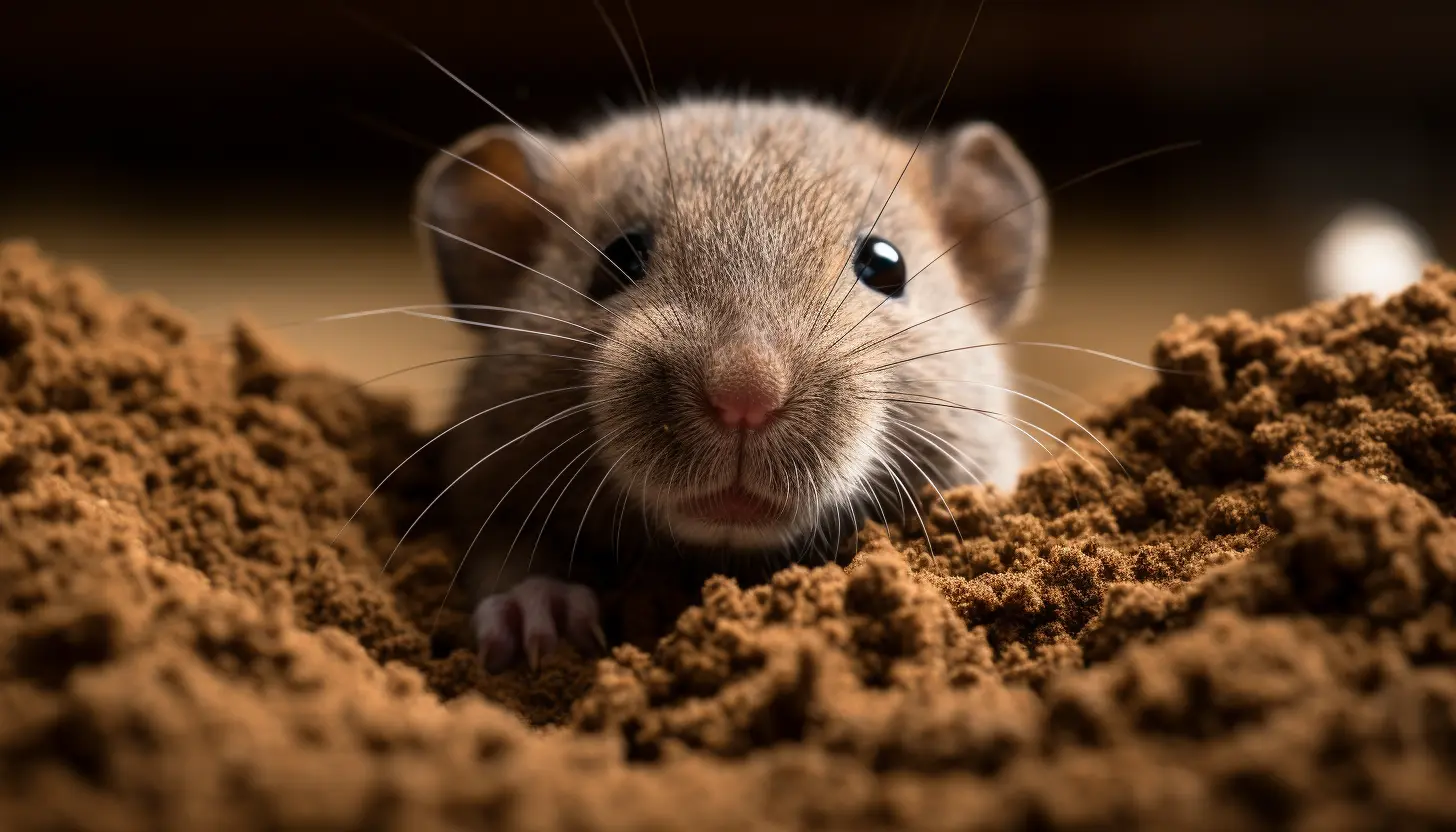Welcome to our comprehensive guide on using coffee grounds to repel voles. If you’re dealing with a vole problem in your garden or yard, you’re not alone. Voles, also known as meadow mice, are small rodents that can wreak havoc on your plants, causing extensive damage. However, there is good news – we have discovered a natural and effective way to keep these little critters at bay: coffee grounds.
Voles are known for their small eyes, short tails, and their ability to create extensive networks of tunnels and runways. They can quickly multiply, leading to a significant vole population and widespread destruction of your garden plants. The damage they cause includes gnawing on roots, bark, and stems, which can ultimately kill your favorite flowers, vegetables, or fruit trees.
While there are numerous vole repellents on the market, many of them contain chemicals that may be harmful to the environment or other wildlife. That’s where coffee grounds come in as a natural solution. Coffee grounds not only have a strong smell that voles find unpleasant, but they also offer other benefits for your plants, making them a great way to tackle your vole problem without resorting to harmful chemicals.
In this guide, we’ll delve into the science behind why coffee grounds repel voles, explore other natural repellents such as castor oil and peanut butter, and provide you with practical tips on effectively using coffee grounds to keep voles at bay. We’ll also discuss other vole control measures, including live traps and physical barriers, to help you combat this frustrating issue.
So, grab a cup of coffee and let’s dive into the world of voles and the power of coffee grounds as a natural vole repellent. By the end of this guide, you’ll be equipped with all the knowledge and techniques you need to protect your garden from these pesky rodents and enjoy a thriving, vole-free outdoor space.
Understanding Voles and Their Behavior
Voles, scientifically known as Microtus, are small rodents that are often mistaken for mice or moles due to their similar size and appearance. However, voles have some distinct characteristics that set them apart. These tiny creatures have small eyes, short tails, and round bodies, making them well-adapted for their underground lifestyle.
Voles are widespread throughout North America, inhabiting various habitats such as meadows, fields, gardens, and even forests. They are prolific breeders, with females capable of producing several litters each year, leading to a rapidly growing vole population if left unchecked.
One of the key factors contributing to the vole’s success is their ability to adapt to a wide range of food sources. Voles are herbivores and primarily feed on grasses, roots, bulbs, tubers, and the bark of trees and shrubs. Their voracious appetite can quickly decimate a garden or orchard, making them a significant nuisance for gardeners and farmers alike.
Voles are most active during the early morning and evening hours, spending the majority of their time underground in a network of tunnels and runways. These tunnels serve as protection from predators and provide easy access to food sources. Voles are excellent burrowers and can create an extensive system of tunnels in a short amount of time.
Identifying a vole infestation can be challenging, as they rarely venture above ground. However, there are certain signs to look out for. Vole runways, which are shallow tunnels on the surface of the ground, can be an indication of their presence. Additionally, gnaw marks on the base of trees, dead plants, and the appearance of small, round holes in the ground are all signs that voles have made themselves at home in your garden.
Now that we have a better understanding of voles and their behavior, we can explore how to effectively control and repel them using natural methods. By utilizing the power of coffee grounds and other natural repellents, we can create a vole-free environment without resorting to harmful chemicals. So, let’s continue our journey and discover the best ways to keep voles at bay.
Exploring Natural Repellents for Voles
When it comes to repelling voles, many people turn to chemical-based repellents or traps. However, these options can be harmful to the environment, wildlife, and even pets. That’s where natural repellents come into play. In this section, we will delve into the effectiveness of coffee grounds, castor oil, and peanut butter as natural vole repellents.
Coffee Grounds as a Vole Repellent
Coffee grounds have long been known for their strong smell, which can be off-putting to many creatures, including voles. The scent of coffee grounds acts as a natural deterrent, making your garden less appealing to these pesky rodents.
To use coffee grounds as a vole repellent, there are a few methods you can try. One option is to sprinkle the grounds directly around the areas where voles are active or where you want to protect your plants. This can be done around the base of trees, along vole runways, or around your vegetable garden. The strong smell of the coffee grounds acts as a barrier, discouraging voles from venturing into those areas.
Another method is to create a coffee ground spray. To make the spray, simply soak a cup of fresh coffee grounds in a gallon of water overnight. The next day, strain the mixture and transfer it to a spray bottle. Spray the solution around the perimeter of your garden or any areas where voles are causing damage. Reapply the spray every few weeks or after rainfall to maintain its effectiveness.
It’s important to note that coffee grounds may not provide instant results. The effectiveness of coffee grounds as a vole repellent may vary depending on the vole population in your area and the intensity of the infestation. However, many gardeners have reported positive results with the regular use of coffee grounds as a natural vole deterrent.
Castor Oil as a Vole Repellent
Castor oil is another natural substance that has shown promise in repelling voles. It works by creating an unpleasant taste and odor that voles find repulsive. The application of castor oil can make your garden less attractive to voles, leading them to seek out alternative food sources.
To use castor oil as a vole repellent, mix a few tablespoons of castor oil with water in a spray bottle. Shake the mixture well to ensure the oil is properly dispersed. Spray the solution around the perimeter of your garden, focusing on areas where voles are active or where you want to protect your plants. Reapply the spray every couple of weeks or after rainfall for continued effectiveness.
Peanut Butter as a Vole Repellent
Peanut butter may seem like an odd choice for repelling voles, but its stickiness can actually deter these small rodents. By placing dollops of peanut butter strategically around your garden or near vole runways, you can create a barrier that voles will try to avoid. The sticky texture of the peanut butter can be irritating to voles, causing them to seek out food sources elsewhere.
When using peanut butter as a vole repellent, it’s important to monitor the dollops and replace them regularly to ensure their effectiveness. Voles may become accustomed to the presence of the peanut butter over time, so it’s essential to maintain a consistent barrier to deter their presence.
While coffee grounds, castor oil, and peanut butter can be effective natural repellents for voles, it’s important to remember that results may vary. Some gardeners have reported significant success with these methods, while others have had limited results. It’s always a good idea to combine different natural repellents and control measures to increase your chances of success.
Implementing Effective Vole Control Measures
While natural repellents can be effective in deterring voles, sometimes additional measures are necessary to combat a vole infestation. In this section, we will explore live traps, physical barriers, and other natural methods that can help control and eliminate voles from your garden or yard.
Live Traps for Vole Removal
Live trapping is a humane and effective method for capturing voles and relocating them to a more suitable habitat away from your property. There are various types of live traps available, including box traps and cage traps. These traps are designed to safely capture voles without causing harm, allowing you to release them in a remote location.
When setting up live traps, it’s essential to place them in areas where voles are active, such as along vole runways or near their burrows. Bait the traps with a food source that voles find enticing, such as fresh vegetables, apple slices, or peanut butter. Check the traps regularly and release any captured voles far away from your property to prevent them from returning.
Physical Barriers to Prevent Vole Damage
Creating physical barriers can be an effective way to protect your plants and garden from vole damage. One option is to install wire mesh or hardware cloth around vulnerable areas, such as the base of trees or raised garden beds. Ensure that the mesh or cloth is buried several inches into the ground to prevent voles from burrowing underneath.
Another method is to create shallow trenches around your garden or plant beds. Dig a trench about 6 inches deep and 6 inches wide, and line it with hardware cloth or wire mesh. This barrier will deter voles from accessing your plants from below the ground.
It’s important to regularly inspect and maintain these physical barriers to ensure their effectiveness. Voles are persistent creatures and may attempt to find new entry points or burrow under existing barriers. Regularly monitoring and reinforcing these measures will help prevent vole damage.
Other Natural Methods for Vole Control
In addition to live traps and physical barriers, there are other natural methods you can employ to control voles. For instance, planting certain plants with strong scents can act as a deterrent. Voles are known to dislike plants such as daffodils, marigolds, and castor beans due to their strong aromas. Incorporating these plants into your garden can help deter voles from entering.
You can also try creating disturbances in the vole’s environment to discourage their presence. This can be done by placing wind chimes or other noise-making devices near their burrows or runways. The loud noises and vibrations can make voles feel unsettled and encourage them to seek quieter areas away from your garden.
Furthermore, some gardeners have had success using natural repellents such as hot peppers or cayenne pepper. Sprinkling these spices around the perimeter of your garden or on vulnerable plants can create an unpleasant taste and smell that voles find repulsive.
By combining live traps, physical barriers, and other natural control methods, you can effectively manage and reduce vole populations in your garden or yard. It’s important to be persistent and proactive in your efforts to ensure long-term success in vole control.
Conclusion and Future Prevention
As we come to the end of our journey exploring the use of coffee grounds and other natural methods to repel voles, it’s important to recap the key points and discuss future prevention strategies. We have learned that coffee grounds can be an effective natural vole repellent due to their strong smell, and they offer a safe and environmentally friendly alternative to chemical-based repellents.
By using coffee grounds, castor oil, peanut butter, and other natural repellents, you can create a vole-free environment in your garden or yard. These methods work by creating barriers or deterrents that make your property less appealing to voles, encouraging them to seek alternative food sources and nesting areas.
However, it’s essential to remember that vole control is an ongoing process. While these natural methods can be effective, they may require regular maintenance and application to ensure their continued success. Voles are persistent creatures, and new populations may move into your area, necessitating ongoing prevention measures.
In addition to using natural repellents, there are other steps you can take to prevent vole infestations in the future. One effective method is to maintain a clean and tidy garden. Removing debris, such as piles of brush or logs, can eliminate potential hiding places for voles. Regularly mowing your lawn and keeping grass and vegetation trimmed can also make your property less attractive to these rodents.
Another preventive measure is to create physical barriers around vulnerable areas. This can include installing wire mesh or hardware cloth around the base of trees, shrubs, or garden beds. Regularly inspecting these barriers for any signs of damage or potential entry points is crucial for their effectiveness.
Additionally, practicing good garden hygiene can help deter voles. Clearing away fallen fruits or vegetables and keeping your garden free from weeds and overgrown vegetation reduces potential food sources for voles. Regularly monitoring your plants for signs of vole damage, such as chewed roots or gnawed bark, can alert you to a potential infestation before it becomes extensive.
In conclusion, the use of coffee grounds, along with other natural repellents and preventive measures, offers a safe, humane, and environmentally friendly approach to controlling voles. By combining these methods and staying vigilant, you can protect your garden, plants, and yard from the damage caused by these small rodents.
Remember, vole control requires patience and persistence. It may take time to find the most effective methods for your specific situation, but with dedication and a proactive approach, you can successfully manage and reduce vole populations in your outdoor space.
So, armed with the knowledge and techniques shared in this guide, it’s time to take action and reclaim your garden from these pesky voles. Enjoy the beauty of your flourishing plants and the peace of mind that comes with knowing you’ve found a natural, effective solution to your vole problem.










